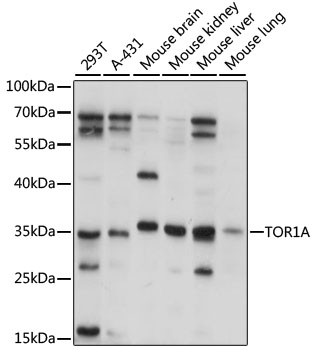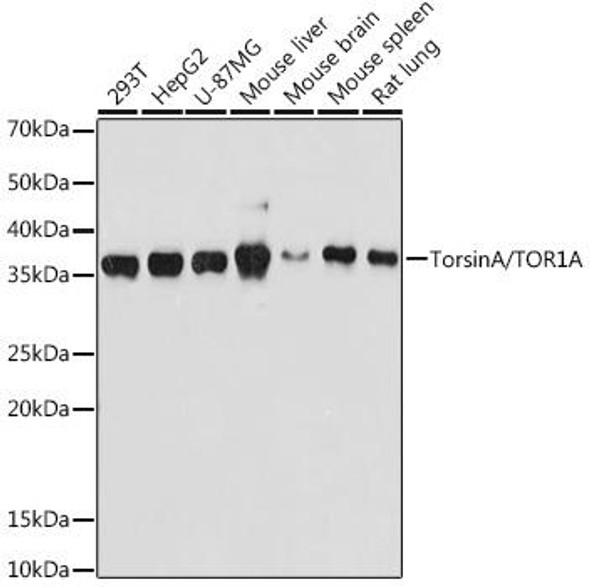Cell Biology Antibodies 5
Anti-TOR1A Antibody (CAB15051)
- SKU:
- CAB15051
- Product Type:
- Antibody
- Reactivity:
- Human
- Reactivity:
- Mouse
- Reactivity:
- Rat
- Host Species:
- Rabbit
- Isotype:
- IgG
- Antibody Type:
- Polyclonal Antibody
- Research Area:
- Cell Biology
Description
| Antibody Name: | Anti-TOR1A Antibody |
| Antibody SKU: | CAB15051 |
| Antibody Size: | 20uL, 50uL, 100uL |
| Application: | WB IHC |
| Reactivity: | Human, Mouse, Rat |
| Host Species: | Rabbit |
| Immunogen: | Recombinant fusion protein containing a sequence corresponding to amino acids 40-300 of human TOR1A (NP_000104.1). |
| Application: | WB IHC |
| Recommended Dilution: | WB 1:500 - 1:2000 IHC 1:50 - 1:200 |
| Reactivity: | Human, Mouse, Rat |
| Positive Samples: | 293T, A-431, mouse brain, mouse kidney, mouse liver, mouse lung |
| Immunogen: | Recombinant fusion protein containing a sequence corresponding to amino acids 40-300 of human TOR1A (NP_000104.1). |
| Purification Method: | Affinity purification |
| Storage Buffer: | Store at -20'C. Avoid freeze / thaw cycles. Buffer: PBS with 0.02% sodium azide, 50% glycerol, pH7.3. |
| Isotype: | IgG |
| Sequence: | PRLY CLFA ECCG QKRS LSRE ALQK DLDD NLFG QHLA KKII LNAV FGFI NNPK PKKP LTLS LHGW TGTG KNFV SKII AENI YEGG LNSD YVHL FVAT LHFP HASN ITLY KDQL QLWI RGNV SACA RSIF IFDE MDKM HAGL IDAI KPFL DYYD LVDG VSYQ KAMF IFLS NAGA ERIT DVAL DFWR SGKQ REDI KLKD IEHA LSVS VFNN KNSG FWHS SLID RNLI DYFV PFLP LEYK HLKM CIRV EMQS RGYE IDED IVSR V |
| Gene ID: | 1861 |
| Uniprot: | O14656 |
| Cellular Location: | Cell projection, Cytoplasm, Cytoplasmic vesicle, Cytoplasmic vesicle membrane, Endoplasmic reticulum lumen, Nucleus membrane, Peripheral membrane protein, cytoskeleton, growth cone, secretory vesicle, synaptic vesicle |
| Calculated MW: | 22kDa/37kDa |
| Observed MW: | 38kDa |
| Synonyms: | TOR1A, DQ2, DYT1, torsin-1A |
| Background: | The protein encoded by this gene is a member of the AAA family of adenosine triphosphatases (ATPases), is related to the Clp protease/heat shock family and is expressed prominently in the substantia nigra pars compacta. Mutations in this gene result in the autosomal dominant disorder, torsion dystonia 1. |
| UniProt Protein Function: | TOR1A: May serve as a molecular chaperone assisting in the proper folding of secreted and/or membrane proteins. In the nucleus, displaces the nuclear membrane proteins SUN2, SYNE2 and nesprin-3/C14orf49, leaving nuclear pores and SUN1 unchanged. May form homohexamers. Interacts with TOR1AIP1 and TOR1AIP2. Interacts with KLHL14, preferentially when ATP-free. Widely expressed. Highest levels in kidney and liver. Not detected in spleen. In the brain, high levels found in the dopaminergic neurons of the substantia nigra pars compacta, as well as in the neocortex, hippocampus and cerebellum. Also high expression in the spinal cord. Belongs to the clpA/clpB family. Torsin subfamily. 2 isoforms of the human protein are produced by alternative splicing. |
| UniProt Protein Details: | Protein type:Secreted, signal peptide; Secreted Chromosomal Location of Human Ortholog: 9q34 Cellular Component: synaptic vesicle; transport vesicle; nuclear membrane; growth cone; cytoskeleton; cytoplasmic vesicle membrane; intracellular membrane-bound organelle; membrane; endoplasmic reticulum lumen; nuclear envelope; cell junction; secretory granule Molecular Function:protein binding; kinesin binding; ATPase activity; cytoskeletal protein binding; unfolded protein binding; misfolded protein binding; ATP binding Biological Process: protein deneddylation; chaperone cofactor-dependent protein folding; organelle organization and biogenesis; synaptic vesicle transport; regulation of dopamine uptake; intermediate filament cytoskeleton organization and biogenesis; response to oxidative stress; cell adhesion; nuclear membrane organization and biogenesis; neurite development; protein homooligomerization Disease: Dystonia 1, Torsion, Autosomal Dominant |
| NCBI Summary: | The protein encoded by this gene is a member of the AAA family of adenosine triphosphatases (ATPases), is related to the Clp protease/heat shock family and is expressed prominently in the substantia nigra pars compacta. Mutations in this gene result in the autosomal dominant disorder, torsion dystonia 1. [provided by RefSeq, Jul 2008] |
| UniProt Code: | O14656 |
| NCBI GenInfo Identifier: | 13878817 |
| NCBI Gene ID: | 1861 |
| NCBI Accession: | O14656.1 |
| UniProt Secondary Accession: | O14656,Q53Y64, Q96CA0, B2RB58, |
| UniProt Related Accession: | O14656 |
| Molecular Weight: | 37,809 Da |
| NCBI Full Name: | Torsin-1A |
| NCBI Synonym Full Names: | torsin family 1, member A (torsin A) |
| NCBI Official Symbol: | TOR1A |
| NCBI Official Synonym Symbols: | DQ2; DYT1 |
| NCBI Protein Information: | torsin-1A; torsin ATPase 1; torsin ATPase-1A; dystonia 1 protein; torsin family 1 member A; dystonia 1, torsion (autosomal dominant; torsin A) |
| UniProt Protein Name: | Torsin-1A |
| UniProt Synonym Protein Names: | Dystonia 1 protein; Torsin ATPase-1A (EC:3.6.4.-); Torsin family 1 member A |
| UniProt Gene Name: | TOR1A |
| UniProt Entry Name: | TOR1A_HUMAN |







